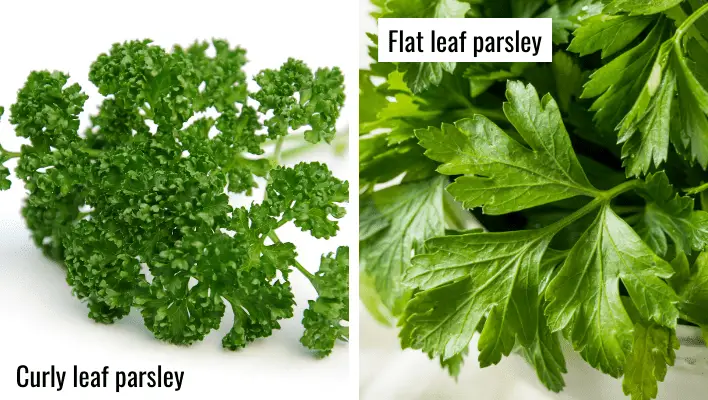This post may contain affiliate links. Please read my disclosure for more information.
Today, I’ll be sharing some of the most popular types of herbs used in cooking along with their uses and also photo illustrations of each.

When it comes to cooking, nothing makes food more amazing than the aroma and flavor of fresh culinary herbs. So, if you’re thinking of upping your herb game in the kitchen, you’ll really enjoy this post as we’re listing all the most popular herbs as well as the recipes they’re best used in.
What are herbs?
Herbs are any plant with leaves, stems or flowers that can be used to flavor food. Herbs can also be used in medicine or even in perfumes.
Thus there are 3 main groupings of herbs including medicinal herbs, aromatic herbs and culinary herbs.
Today, this post will focus on the different types of culinary herbs used to flavor foods!
Types of herbs
When it comes to the culinary herbs, there are two main types namely delicate herbs (or tender herbs) and hearty herbs which are also called robust herbs or resinous herbs.
Delicate herbs are herbs that have a higher moisture content, bruise easily and have more delicate stems. As such, delicate herbs cannot sustain longer periods of cooking as they would become flavorless and indistinctive.
These herbs are best added at the last minute in the cooking process to provide the most flavor impact.
You can identify delicate herbs by their more delicate stems. Some examples of delicate herbs include cilantro, parsley, basil, mint, dill, chives and tarragon.
Hearty herbs on the other hand, are herbs that are more robust and can be added earlier in the cooking process to allow the flavors to infuse into the recipe. Hearty herbs aren’t likely to bruise easily and can be easily identified by their woodier stems.
Some examples of hearty herbs are marjoram, sage, rosemary, oregano and thyme.
Note: The phrases hearty herbs and delicate herbs do not refer to the flavor of the herbs per se, but rather how able they are to withstand longer periods of cooking.
Delicate herbs
The most popular delicate herbs include:
Cilantro

Cilantro refers to the leaves and stems of the cilantro plant. To identify cilantro look for a green herb with long stalks and flat leaves that are somewhat rounder than parsley leaves.
Cilantro has a pungent, citrusy and tangy flavor, but many people who don’t like cilantro say it tastes like soap.
Cilantro is used a lot in Mexican recipes such as chili, salsa, guacamole, and as a garnish for enchiladas, tacos, burritos and more.
Parsley

Parsley is a green herb from the Apiaceae or Umbelliferae family that is native to the Mediterranean region. It is very versatile and the two most common types used are flat leaf parsley and curly leaf parsley.
Flat leaf parsley is often confused with cilantro leaves. The major difference between the two is that flat leaf parsley has more pointy leaves.
Parsley has a fresh, grassy smell and a clean, peppery taste with some earthiness.
Parsley is used popularly as a garnish, as a fresh addition to sauces, condiments or salads. It’s also great for topping stews, soups, pastas, grilled vegetables and more.
Basil

Basil is a fragrant, annual herb from the mint family which is native to India.
Basil leaves are bright green, glossy, oval shaped, smooth with edges that curl inward and form a slight cup. Basil leaves also have a slightly bumpy look along the veins of the leaves.
This herb is most commonly used to make recipes like pesto, to add to pizzas, to add to salad, to fish, meat and sauces.
Dill

Dill is an annual herb in the celery family that is native to the eastern Mediterranean and western Asia.
To identify dill, you can look for a thin plant that grows up to 2-4 feet tall with branching stems that have fibre-like, tiny, wispy leaves that are also blue-green in color.
This fragrant herb has a strong, licorice flavor with hints of anise, fennel and celery and it is used to garnish soups, added to salads, added to fish dishes, lamb dishes and so much more.
Mint

Mint is a perennial aromatic herb from the Lamiaceae family that is Native to eastern Mediterranean. There are hundreds of varieties of mint including spearmint, peppermint, wild mint, apple mint, water mint etc.
Typically the mint herb has oval shaped bright green leaves that are toothed with tiny flowers that can either be purple, white or pink.
Generally, mint is subtly sweet with a lingering cooling effect felt on the tongue. It is also very aromatic and so it is great for flavoring foods and drinks including cocktails, desserts like mint chocolate chip ice creams, salads, soups, teas and more.
Chives

Chives are a culinary herb, with edible leaves and flowers, related to onions and garlic from the allium family. But unlike onions and garlic, they don’t have an edible bulb. Instead, the entire long strand of chive is edible.
Chives grow from underground bulbs clumped together and have the appearance of tall, green strands of grass. They produce round pink flowers in the middle of summer.
Chives have a delicate onion flavor and can be compared in taste to leeks.
Since chives are mildly flavored they work well as a last minute addition to soups, mashed potatoes, dips, as a garnish for omelets, deviled eggs, and a host of other recipes.
Tarragon

Tarragon is a perennial, highly aromatic, green leafy herb from the sunflower family that has a mild licorice flavor. Tarragon is thought to be native to Siberia.
Tarragon has long, slender, spear shaped leaves that are light green and glossy.
In its fresh form, this herb has a very light, underwhelming licorice flavor with hints of citrus.
Tarragon is great for adding to eggs, garnishing poultry and seafood and adding to sauces such as pesto and aioli.
Hearty herbs
Marjoram

Marjoram also called sweet marjoram is an aromatic culinary herb from the mint family that is popular in salad dressings and meat dishes.
Marjoram can be identified as having oval-shaped, green fuzzy leaves that tend to grow in clusters and woody stems.
This herb has a delicate, citrusy flavor with a mild bitter undertone.
Fun fact: Marjoram is very similar to oregano but it is milder.
This herb is used in spice blends, added to stews, soups, braises, sprinkled on top of vegetables, added to salad dressing, poultry dishes, preserved meat and even used for teas.
Sage

Sage is a perennial herb that is also a member of the mint family.
You can identify sage by its gray-green oblong shaped leaves that are covered with lots of tiny hairs that make the leaves look silky.
Sage has a strong herbal scent and earthy flavor with hints of mint, lemon and eucalyptus. It is often used in marinades, sauces, and infused in butter.
Rosemary

Rosemary is a fragrant herb from the mint family that is native to the Mediterranean region.
Rosemary herb has gray-green leaves that look like small pine needles and can grow up to 2 meters in height.
This herb has a strong lemon pine flavor, with notes of lavender, mint, sage and evergreen. It is great for adding to chicken, seafood, stuffing, soups, stews, and even beverages.
Oregano

Oregano is a popular herb from the mint family native to Mediterranean countries and western Asia.
Oregano is a bold herb with a sweet, peppery, pungent and earthy flavor and it works great in poultry, marinades, vinaigrettes, for sauces and more.
Thyme

Thyme is a herb from the mint family that is native to Eurasia.
To identify thyme, look for a herb that has very small oval leaves that grow in clusters on a woody stem.
This herb is very aromatic and has an earthy flavor with notes of mint, lemon and cloves.
Thyme is a popular herb that is used in vegetables, bread, soups, stews and so much more. Read more about type in this post about the best thyme substitutes.
Lavender

Lavender is an aromatic herb from the mint family that has its origins in the Mediterranean. This herb is popularly used in beauty products for its soothing and aromatic qualities, but also often used in food preparations.
Lavender can be identified as being a small plant with spreading shrubs and long flowering shoots that typically have small light purple or blue flowers and grey-green narrow leaves.
This herb can also be described as having a sweet, herbal and woodsy scent among other words. Read more about the replacements for lavender here.
Bay leaves

Bay leaves are another type of hardy herbs from the from the Laurus nobilis or the bay laurel tree.
Bay leaves can be purchased as fresh whole leaves, dried whole leaves or as bay leaf powder, but it is more popular as the dried whole leaf. This is so because this herb is highly aromatic in both powdered form and the dried form, while more subtle when the leaves are fresh and bright green.
Bay leaves are hardy herbs which can withstand longer cooking times. Therefore, they can easily impart their amazing aromatic properties to dishes like pot roasts, seafood boils, braises, soups, stews, rice and more. You can read more about bay leaves and its best substitutes here.
Other types of herbs
Besides delicate and hearty herbs, there are also perennial herbs and annual herbs. These types of herbs are not dependent on whether or not a herb can or cannot withstand cooking.
Instead, these types of herbs are better explained by how they survive due to climate. For example, perennial herbs will grow then die down (or look like it’s dead) in the winter and sprout back up in spring or summer.
Perennial herbs live for up to 2 years or more and once a perennial herb is established it will continue to grow and spread each year.
Some examples of perennial herbs are oregano, thyme, chives, mint, tarragon, marjoram, rosemary, sage, lemon balm, lemon grass and fennel.
Annual herbs on the other hand are herbs that die off completely during winter and have to be replanted the following year.
Annual herbs live for only one year, so many people store as much of these annual herbs as they can for winter time. Some examples of annual herbs are basil, cilantro, dill, chamomile, summer savory, cilantro and parsley.
So, some perennial herbs can be identified as delicate or hearty herbs. Similarly some annual herbs can be identified as delicate or hearty herbs too.
These are the different types of herbs that are used in cooking. They range from delicate to hearty, to perennial and annual and all work great in various dishes.
So, now that you know some more about the different types of herbs as well as their uses, you can really dive in and make these yummy recipes!


